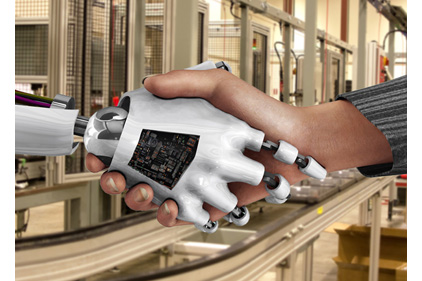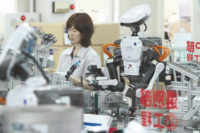Volkswagen AG has deployed a robot that works alongside humans at its engine assembly plant here. The six-axis robotic arm is located in the cylinder head assembly section, where it is responsible for inserting delicate glow plugs into cylinder heads.
“This is the first collaborative robot in use at Volkswagen worldwide,” says Jurgen Hafner, project manager at VW’s plant in Salzgitter, Germany. “Due to its integrated safety mode, the robotic arm is able to collaborate directly with people without any guards. It thus contributes significantly toward optimizing healthy working processes.”
The Saltzgitter facility is one of the largest engine assembly plants in the world. Every day, employees produce 7,000 gas and diesel engines in more than 370 variants ranging from three to 16 cylinders. The engines are used in a wide variety of VW automobiles and trucks, as well as numerous Volkswagen Group brands, such as Audi, Bugatti, Porsche, Seat and Skoda.
The robot is equipped with a collaborative gripper developed exclusively for Volkswagen that meets the safety requirements of ISO/TS 15066, the specification standard for collaborating robots. That allows the robot to be integrated into the assembly line without a protective housing.
A UR5 lightweight robot from Universal Robots picks up the glow plugs and inserts them into hard-to-reach drill holes. A human assembler is then responsible for tightening the glow plugs and for insulating the cylinder head, which is required for the next step in production.
In the past, two humans had to insert the glow plugs in a stooping posture into the scarcely visible cylinder head drill holes. This step is now handled by the six-axis robot. An operator is responsible for fixing the glow plugs and for insulating the cylinder head.
“Thanks to the robot, they [now] carry out these activities in an upright, healthy posture,” says Hafner. “In doing so, [the operator] is able to keep a constant watch over the process, so as to be able to intervene quickly when necessary.
“We would like to prevent long-term burdens on our employees in all areas of our company with an ergonomic layout,” adds Hafner. “By using robots without guards, they can work together hand in hand with the robot. In this way, the robot becomes a production assistant and, as such, can release staff from ergonomically unfavorable work.”









